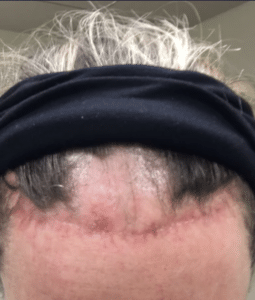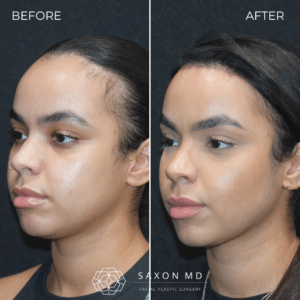Forehead reduction surgery, also known as hairline lowering, has gained popularity in recent years, particularly through social media platforms like TikTok. While many patients achieve satisfactory results, some cases of forehead reduction surgery gone wrong serve as stark reminders of the procedure’s risks. This blog post examines two such cases and discusses prevention strategies for those considering the surgery.
What is Forehead Reduction Surgery?
Forehead reduction is a cosmetic procedure aimed at reducing the height of the forehead by lowering the hairline. Ideal candidates typically have a naturally high hairline or large forehead, good hair density, and some scalp laxity. However, not everyone is suitable for this surgery, and careful patient selection is crucial to minimize complications.
Cases of Forehead Reduction Surgery Gone Wrong
Case 1: Permanent Scarring and Hair Loss
A 25-year-old woman’s story, reported by the Daily Mail, highlights the potential risks of forehead reduction surgery. After undergoing the procedure, she experienced significant complications, including permanent scarring and hair loss. The patient, who had the surgery to address insecurities about her high forehead, now faces long-term consequences that have severely impacted her self-esteem and quality of life.
 .
. 
Case 2: Extensive Shock Hair Loss
Another case, shared on RealSelf, involves a patient who experienced extensive shock hair loss following forehead reduction surgery. The patient reported significant hair shedding around the incision site, raising concerns about the permanence of the hair loss and the overall outcome of the procedure. This case underscores the unpredictable nature of post-surgical healing and the importance of understanding potential complications before undergoing the procedure.

Major Complications of Forehead Reduction Surgery
While many forehead reduction surgeries are successful, it’s crucial to understand the potential complications that can lead to cases of forehead reduction gone wrong. Here’s a detailed look at each major complication:
1. Wide or Thick Scars
One of the most visible complications of forehead reduction surgery is the development of wide or thick scars. These occur when the incision doesn’t heal as finely as anticipated, resulting in a noticeable line across the forehead. Factors contributing to this include excessive tension on the wound, poor wound closure technique, or individual healing characteristics. Wide or thick scars can be particularly distressing for patients, as they can be difficult to conceal and may require additional procedures like scar revision or camouflage techniques.
2. Temporary or Permanent Hair Loss
Hair loss is a significant concern in forehead reduction surgery. Temporary hair loss, known as shock loss, can occur around the incision site due to trauma to the hair follicles during the procedure. While this often resolves within a few months, some patients experience permanent hair loss. This can happen if hair follicles are damaged during the surgery, either through direct injury or compromised blood supply. Permanent hair loss can lead to an unnatural-looking hairline or patchy areas along the incision, significantly impacting the aesthetic outcome of the surgery.
3. Skin Necrosis
Skin necrosis is a severe complication that can occur when the blood supply to the forehead skin is compromised during surgery. This can result in areas of skin dying and sloughing off, leading to open wounds, delayed healing, and potential scarring. Skin necrosis not only poses health risks but can also severely affect the aesthetic outcome, potentially necessitating additional reconstructive procedures.
4. Asymmetry
Achieving perfect symmetry in forehead reduction can be challenging, and some degree of asymmetry is common. However, noticeable asymmetry can occur if the hairline is lowered unevenly or if there’s differential healing on each side of the forehead. This can result in an unbalanced appearance, with one side of the forehead appearing higher or more rounded than the other, potentially requiring revision surgery to correct.
5. Unnatural-Looking Hairline
Creating a natural-looking hairline is crucial in forehead reduction surgery. An unnatural result can occur if the new hairline is placed too low, creating an overly short forehead, or if it’s shaped in a way that doesn’t complement the patient’s facial features. Additionally, if the hair follicles at the new hairline are damaged or oriented incorrectly, it can result in an artificial appearance that’s difficult to style naturally.
6. Nerve Damage
The forehead contains several important sensory nerves. During surgery, these nerves can be stretched or inadvertently cut, leading to numbness, tingling, or altered sensation in the forehead and scalp. In some cases, this nerve damage can be permanent, affecting the patient’s ability to feel or move parts of their forehead. More severely, damage to motor nerves can result in partial or complete loss of forehead movement, affecting facial expressions.

Prevention Techniques for Safer Forehead Reduction
To minimize the risk of complications and avoid cases of forehead reduction gone wrong, experienced surgeons employ several sophisticated techniques:
1. Avoiding Excessive Scalp Stretching
One of the key principles in preventing complications during forehead reduction surgery is to avoid overstretching the scalp. Excessive tension can lead to a range of issues, including wide scars, hair loss, and even skin necrosis. Skilled surgeons carefully assess the scalp’s elasticity before and during the procedure, ensuring that they only advance the hairline as much as the individual patient’s anatomy safely allows. This might involve staging the procedure for patients requiring significant advancement, rather than attempting too much in a single surgery.
2. Judicious Use of Cautery or Raney Clips
Controlling bleeding during surgery is crucial, but it must be balanced with preserving hair follicles and blood supply to the scalp. The judicious use of cautery (a technique to seal blood vessels) or Raney clips (which compress blood vessels without damaging them) is essential. Overuse of cautery can damage hair follicles and compromise blood supply, leading to hair loss or skin necrosis. Experienced surgeons use these tools sparingly and precisely, focusing on larger blood vessels while minimizing trauma to the surrounding tissues.
3. Incorporating Growth Factors like Platelet-Rich Fibrin (PRF)
The use of growth factors, particularly Platelet-Rich Fibrin (PRF), has shown promise in improving healing outcomes in forehead reduction surgery. PRF is derived from the patient’s own blood and contains a high concentration of platelets and growth factors. When applied to the surgical site, it can promote faster healing, reduce inflammation, and potentially enhance hair growth. This technique may help minimize complications such as prolonged healing, excessive scarring, and hair loss.
4. Using Hypochlorous Acid to Prevent Inflammation
Hypochlorous acid, a naturally occurring substance in the human body, has antimicrobial and anti-inflammatory properties. Its use in wound care has been shown to promote healing and reduce the risk of infection. In forehead reduction surgery, applying hypochlorous acid to the incision site can help manage inflammation, potentially leading to better scar formation and reduced risk of complications. This approach is particularly beneficial in the immediate post-operative period when proper wound care is crucial.
5. Strategic Suture Placement to Reduce Tension
The placement of sutures is a critical factor in achieving optimal results and preventing complications in forehead reduction surgery. Strategic suturing techniques aim to distribute tension evenly across the incision, reducing the risk of wide scars and ensuring proper wound closure. This often involves a layered closure approach, with deeper sutures supporting the scalp advancement and finer sutures for precise skin alignment. Some surgeons also employ special suturing techniques, such as trichophytic closure, which can help conceal the incision line within the hairline for a more natural result.

Managing Complications: What to Do if Forehead Reduction Surgery Goes Wrong
Despite best efforts, complications can sometimes occur after forehead reduction surgery. If you find yourself dealing with issues following your procedure, it’s crucial to work closely with your surgeon or seek a second opinion from a board-certified plastic surgeon experienced in revision procedures. Here are some approaches to managing common complications:
Treating Scarring Issues
Scarring is one of the most common concerns in cases of forehead reduction gone wrong. Fortunately, several treatments can help improve the appearance of scars:
- Microneedling: This technique involves creating tiny punctures in the skin to stimulate collagen production. It can be effective in reducing the appearance of scars and improving overall skin texture. Multiple sessions are typically required for optimal results.
- Laser Treatments: Various laser therapies, such as fractional laser resurfacing, can help minimize scarring. These treatments work by removing outer layers of skin and stimulating collagen production. The choice of laser depends on the specific type and severity of scarring.
- Scar Revision Surgery: For more severe or problematic scars, a surgical revision may be necessary. This procedure involves excising the old scar and carefully re-closing the incision to create a less noticeable scar. It’s crucial to wait until the initial scar has fully matured (usually 6-12 months post-surgery) before considering revision.
- Micropigmentation: This technique, essentially a medical form of tattooing, can be particularly useful for hypopigmented (lighter than surrounding skin) or hyperpigmented (darker than surrounding skin) scars. A skilled practitioner can blend the scar color with the surrounding skin tone, making it less noticeable.
Addressing Hair Loss
Hair loss along the incision line or in surrounding areas can be distressing. Here are some options to consider:
- Hair Grafts: If you’ve experienced permanent hair loss, hair transplantation can be an effective solution. Individual hair follicles are harvested from donor areas (usually the back of the scalp) and carefully implanted along the incision line or in areas of thinning. This can help create a more natural-looking hairline and camouflage scarring.
- Scalp Micropigmentation: For areas where hair regrowth is not possible, scalp micropigmentation can create the illusion of hair follicles. This technique involves tattooing pigment into the scalp to mimic the appearance of short hair stubble.
- Topical Treatments: In cases of temporary hair loss or thinning, topical treatments like minoxidil or prescription medications may help stimulate hair regrowth. These should be used under the guidance of a healthcare professional.
Managing Skin Issues
For complications involving skin quality or healing:
- Hypochlorous Acid: Continued use of hypochlorous acid can help manage inflammation and promote healing in the early stages of recovery.
- Silicone-Based Products: Silicone sheets or gels can be effective in improving the appearance of scars and promoting better healing.
- Steroid Injections: For hypertrophic or keloid scars, your surgeon might recommend steroid injections to help flatten and soften the scar tissue.
The Importance of Choosing an Experienced Surgeon
The cases of forehead reduction surgery gone wrong highlight the critical importance of selecting a highly experienced surgeon specializing in this procedure. An expert in forehead reduction not only possesses the technical skills to perform the surgery but also the judgment to prevent potential problems before they occur. Patients considering forehead reduction should thoroughly research their options, consult with multiple board-certified plastic surgeons, and carefully weigh the potential risks and benefits before surgery.
You may also like:
- 6 Factors That Determine the Amount of Hair Growth Through the Incision After Hairline Lowering
- Top 5 Things You Wish You Knew Before Hairline Lowering Surgery
- How to Camouflage Your Incision After Hairline Lowering Surgery
- Hairline Lowering vs Hair Grafts: Understanding Your Options for a Better Hairline
- Understanding Shock Hair Loss: 6 Causes, Recovery, and Management
- Forehead Reduction Surgery Before and After

